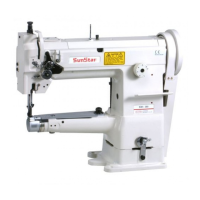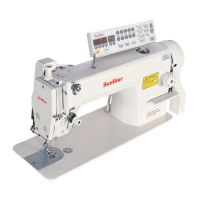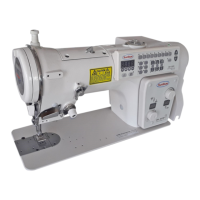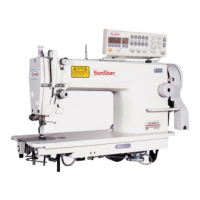17
[Figure 23]
4) Routing the lower thread
[Applicable model]
KM-757
KM-757BL
KM-757-7S
KM-757-7N
[Applicable models]
KM-757BL-7S
KM-757BL-7N
1. Insert the bobbin ① into the hook ②.
2. Insert the thread through “A”part of the hook ②, and pull
it out from the end of the lower thread tension adjustment
plate ③.
3. The adequate length of the pulled-out lower thread is
50mm.
1. Insert the bobbin ① into the bobbin case ②. For KM -757-7S and
KM-97-7N, it is crucial to insert the bobbin in the turning direction as
in the picture.
2. Insert the thread through “A”part of the hook ②, and pull it out
from the end of the lower thread tension adjustment plate ③.
3. Pass the pulled-out thread through “B”and “C”of the bobbin case
②, as can be seen on the picture, and hang it onto the lower thread
holding spring ④. Then pull it out through the thread hole ⑤.
4. The adequate length of the pulled-out lower thread is 50mm.
[Applicable models]
KM-797
KM-797BL
KM-797-7S
KM-797-7N
[Applicable models]
KM-797BL-7S
KM-797BL-7N
3) Winding the lower thread
(1) Winding the lower thread
A.
Push the thread through the hole ① and wind it from
the back to the front of the tension adjusting plate ②.
B. Bring the thread toward the bobbin ③ and wind the
thread around the bobbin about 5-6 times in the
clockwise direction.
C. Push the lever ④ so that the pulley ⑤ will touch the
V-belt, operate the machine.
D.
Once the lower thread is wound around the bobbin, the
pulley ⑤ automatically pulls apart from the V-belt.
E. About 80% of the bobbin should be wound with the
lower thread. (See Figure 22.)
(2) Adjusting lower thread
a. If the lower thread is not being wound evenly, loosen the screw ⑥ and adjust it by moving it left and right. Then,
tighten the screw again.
b. The lower thread is wound more if the adjusting screw ⑦ is turned clockwise, and less if turned counterclockwise.
c. The tension of the lower thread being wound around the bobbin becomes tighter if the nut ⑧ is turned clockwise and
looser if turned counterclockwise.
[Figure 22]

